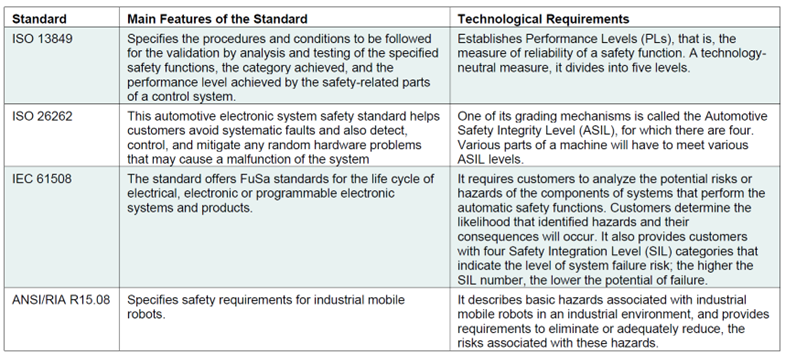The necessity of safety standards for industrial robots has never been more apparent. Industrial robot systems are increasingly more common in manufacturing and logistics applications. By 2030, ABI Research expects nearly twice as many annual industrial robot shipments as in 2022—increasing from 436,000 units to 815,000 units.
While these automated technologies can boost productivity and mitigate the adverse effects of labor shortages, a warehouse or manufacturing facility heavily populated with robots can become less safe. If there aren’t robust safety requirements to follow, there’s a significant risk of harm to human workers.
As industrial robots find their way into a greater number of work environments, the influence of safety standards will only be amplified.
What Are Industrial Robot Safety Standards?
Industrial robot safety standards can be thought of as agreed-upon principles that ensure an industrial robot system is manufactured and used in a safe manner.
The three most important international standards for industrial robots include:
- The International Electrotechnical Commission (IEC) 61508: Provides functional safety standards for the lifecycle of electrical, electronic, or programmable electronic systems and products. On the technology front, mobile robotics users must identify potential risks or hazards of component or system failures. For example, materials handling is the largest application for mobile robots, but that comes with major risk if the proper safety protocols are not in place.
- The International Organization for Standardization (ISO) 13849: Lays out the specific procedures and conditions that industrial robots should follow for validating and testing robot safety functions. The safety standard also stipulates Performance Levels (PLs) to measure the reliability of safety functions.
- ISO 26262: An automotive safety standard that supports robotics users in their efforts to avoid systemic issues. Moreover, the ISO 26262 standard helps mitigate random hardware faults that could lead to a robotics system malfunction.
Table 1: International Safety Standards for Robotics

These international robot safety standards ensure that industrial robot users around the world have clear guidance on how to keep humans safe in work environments using robots.
Moreover, many national standards and certifying bodies, such as the American National Standards Institute (ANSI) and the British Standards Institution (BSI), often adopt international standards and modify them according to regional safety requirements for industrial robots.
Industrial Robot Safety Standards Are Just the First Step to Safer Work Environments
It’s important to note that, while compliance with international robot safety standards is technically voluntary, it’s by and large an expectation in the industry. These safety standards assure vendors, clients, and employees that safety requirements are being taken seriously.
There are still some gray areas in robot safety regulation. This can cause ambiguity for some safety definitions, descriptions, and requirements. To help circumvent this problem, there should be strong consideration among standardization bodies, such as the ISO and IEC, to publish more “working standards”. In other words, even if the robot safety standard isn’t finalized, robotics companies can see what proposals are being considered for the next release.
Finally, the importance of automatic protection for industrial mobile robot safety cannot be understated. While standardization and legal regulations are the driving forces in robot safety, a convergence with technological solutions is a must.
To learn more, download ABI Research’s Bringing Functional Safety and Risk Prevention to Industrial and Commercial Robots research report. This report is part of the company’s Industrial, Collaborative & Commercial Robotics Research Service.

